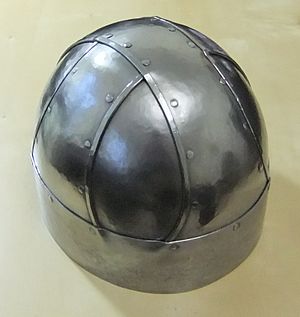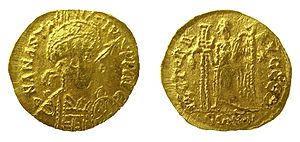Shorwell helmet facts for kids
Quick facts for kids Shorwell helmet |
|
|---|---|

The Shorwell helmet
|
|
| Material | Iron |
| Created | 500–550 AD |
| Discovered | 2004 Shorwell, Isle of Wight |
| Present location | British Museum, London |
| Registration | 2006,0305.67 |
The Shorwell helmet is an ancient helmet from the Anglo-Saxon period. It was found near Shorwell on the Isle of Wight in southern England. This helmet is about 1,500 years old, from the early to mid-500s AD.
It belonged to an important Anglo-Saxon warrior and was buried with him. Other items found included a special sword and a decorative bowl. This helmet is very rare. It is one of only six Anglo-Saxon helmets ever found. Unlike the others, it was made in a style from the Frankish lands, which is now France. The other helmets found in England and Scandinavia had a different "crested" style.
Members of a metal detecting club found the grave in May 2004. Archaeologists then carefully dug it up in November. Farm work had damaged many graves in the area. This meant the Shorwell helmet's grave was the only one that could be clearly identified.
The helmet was broken into about 400 pieces. It was first thought to be just a "fragmentary iron vessel." Only after the British Museum bought it and put it back together was it identified as a helmet. It is now part of the museum's collection.
The Shorwell helmet was a strong, practical helmet for fighting. It had very little decoration, maybe just an outside leather cover. It was built simply from eight pieces of iron joined with rivets. Any small decorations it had also served a purpose. Even though it looks plain, this helmet is very important. Helmets were rare in Anglo-Saxon England. Only high-ranking people likely owned them. Finding so few helmets suggests their owners were very important.
Contents
What the Shorwell Helmet Looks Like
This helmet was made from eight pieces of iron joined together. A band went around the forehead, about 620 millimeters (24 inches) long. Another band ran from the nose to the back of the neck, about 340 millimeters (13 inches) long. Two side bands went from above the ears to the top of the helmet.
These bands were narrower at the top and wider near the forehead band. Four triangle-shaped plates filled the gaps inside the helmet. These plates were carefully placed, showing the maker's skill. The helmet was mostly symmetrical, meaning it was balanced on both sides.
The Shorwell helmet had very few decorations. It might have had an outer covering of leather. The nose-to-nape and side bands had thicker edges. These might have been decorative, but they also helped protect the wearer. They could stop weapons from sliding down and hitting the face or shoulders.
Three copper alloy rivets were found on one side of the forehead band. These might have held a strap or a cheek guard. These special rivets, made of copper alloy instead of iron, might have been a small decoration. It's possible the helmet was covered in decorated leather or cloth. However, the helmet is too damaged to be sure.
There might have been a lining inside the helmet. Traces of what might be skin were found inside. This could have been part of a lining or a cheek guard. Some other old helmets also show signs of leather linings. If so, this would have made the helmet more comfortable and protective.
How Old Is This Helmet?
The Shorwell helmet is from about 500 to 550 AD. This date is based on comparing it to similar helmets and other items found in the grave. It is one of only six Anglo-Saxon helmets known. But it's special because it's in a different style.
The other five helmets are "crested helmets" from Northern Europe. The Shorwell helmet is in the style of the continental Frankish people. Similar helmets have been found in Belgium and Germany. These Frankish helmets seem to be based on older Late Roman helmets.
Why Was This Helmet Made?
The Shorwell helmet was a practical tool for fighting. It had very few decorations. Any decorative parts also had a useful purpose. For example, the flared ends and raised edges of the bands looked nice. But they also made the helmet stronger and protected against blows. The copper alloy rivets were for a strap or cheek flap. This shows it was mainly a "fighting helmet." It was simple but well-made and strong.
Helmets were rare in Anglo-Saxon England. Even though it was a practical item, the Shorwell helmet showed the high status of its owner. Only wealthy people could afford such protection. In the old poem Beowulf, which is about kings and nobles, helmets are common. Graves of rich non-royals in Sweden from the same time also had helmets.
However, thousands of Anglo-Saxon graves have been dug up. Yet, helmets are still very rare. This suggests they were not buried in large numbers.
How the Helmet Was Found
The helmet was found in November 2004 near Shorwell. This is a village on the Isle of Wight. The Isle of Wight Metal Detecting Club found Anglo-Saxon grave items in May of that year. They reported their finds, as required by law.
Farm plowing had badly damaged the graves. Only one grave could be clearly identified. Archaeologists found evidence of an important male warrior from the early to mid-500s. At the head of the grave were about 400 pieces of iron. These were first thought to be parts of an "iron vessel."
The warrior was buried with other items. An iron pattern-welded sword was found next to a copper alloy buckle. The sword's silver handle and a gilded mouthpiece were found nearby. Also found were a shield boss (the center part of a shield), a broken spearhead, a glass cup, and pieces of a hanging bowl.
Close by, a gold mount with glass and garnet was found. In 2007, a gold Merovingian or Burgundian copy of a Roman coin was also found. This coin showed the Eastern Roman Emperor Anastasius I. He ruled from 491 to 518 AD. The coin was a copy made in Gaul (modern France) around 500 to 580 AD.
The Isle of Wight Museum Service was interested in the finds but later withdrew. The British Museum bought the objects in 2006. The items, including the helmet (which was still thought to be a broken vessel), were valued at £3,800. Later finds, like the gold coin, were also bought by the museum.
Putting the Helmet Back Together
The "fragmentary iron vessel" was sent to the British Museum for repair. It was found near where the warrior's head would have been. So, experts decided to try and rebuild it as a helmet. This has happened before with other helmets. For example, a Roman helmet was once called "cauldron fragments." The Anglo-Saxon Pioneer helmet was first called a "bucket." And the Coppergate helmet was thought to be a rock.
The helmet pieces were very rusty and bent. This made the repair difficult. Layers of metal had also come apart. These layers had to be glued back together before joining the pieces. The fragments were only lightly cleaned to keep any traces of old organic material. X-rays were used first to sort the pieces by their thickness and curve.
About two-thirds of the helmet was then put together. This proved it was indeed a helmet. The remaining pieces were not enough to complete the helmet. This suggests that farm plowing had damaged it.
The Shorwell helmet is now in the British Museum's collection. As of 2018, it is not on public display.
Why This Discovery Is Important
Grave Goods and What They Tell Us
The Shorwell helmet was buried with an important male warrior in the early to mid-500s. During this time, burials often included items like meat, pottery, metal vessels, and sometimes weapons. Weapon burials from the 400s and 500s usually had a spear, shield, and sword. Other weapons like axes or arrowheads were rarer.
By the 600s, new types of weapons became popular in graves. These included seaxes (a type of knife) and shields with sugar-loaf bosses (a cone-shaped center). The items placed in a grave could tell us about the person's status, wealth, gender, age, and tribal group. Studies of early Anglo-Saxon graves show that weapons were almost always buried with men. They were symbols of being a man. It is very rare to find weapons in women's graves from this period.
The Isle of Wight's History
The Isle of Wight is an island in the English Channel. It is about 3 kilometers (2 miles) off the coast of Great Britain. Shorwell, where the helmet was found, is a small village on the island's southwest side. People have lived there since the Stone Age. It was also settled during the Roman time in Britain.
The sixth-century helmet fits into the Early Middle Ages. This time was once called the Dark Ages because there were few written records. Two important books, along with archaeological finds, help us understand this period in Britain. They also suggest how the Anglo-Saxons came to the Isle of Wight. These books are the Anglo-Saxon Chronicle and the Ecclesiastical History of the English People by the monk Bede.
Germanic invasions happened for decades before the Romans left Britain in 410 AD. More invasions followed. Around the mid-400s, these invasions led to permanent Germanic control. A legend says that two mercenary brothers, Hengist and Horsa, turned against a British king. They plundered the island and set up rule in Kent.
Bede's writings and similar grave goods suggest that people from Kent also settled on the Isle of Wight. Another settlement was across the Solent, near Southampton Water. A story in the Chronicle says Cerdic, a king of Wessex, conquered the island in 530 AD. However, Cerdic's story is questioned and might be a later tale.
What we do know is that Kent was a center for new ideas and trade from Europe in the 500s. Its connection with the Isle of Wight brought goods and visitors across the Channel. This might explain the items found in the Shorwell grave, and even who the buried person was.




